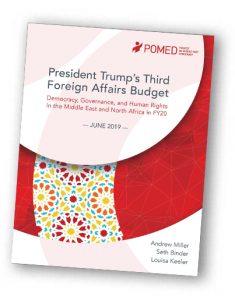 President Donald Trump’s third international affairs budget request reminds one of the movie “Groundhog Day.” His administration’s Fiscal Year (FY) 2020 request, as with the previous two iterations, calls for significant cuts in the assistance funded by the State and Foreign Operations appropriations bill. The top-line request of $42.8 billion is a startling 21.3 percent lower than what Congress authorized for the State Department and U.S. Agency for International Development (USAID) in the FY19 Consolidated Appropriations Act. Particularly concerning are the proposed cuts of more than 50 percent to democracy and governance programs and 34 percent to humanitarian assistance worldwide.
President Donald Trump’s third international affairs budget request reminds one of the movie “Groundhog Day.” His administration’s Fiscal Year (FY) 2020 request, as with the previous two iterations, calls for significant cuts in the assistance funded by the State and Foreign Operations appropriations bill. The top-line request of $42.8 billion is a startling 21.3 percent lower than what Congress authorized for the State Department and U.S. Agency for International Development (USAID) in the FY19 Consolidated Appropriations Act. Particularly concerning are the proposed cuts of more than 50 percent to democracy and governance programs and 34 percent to humanitarian assistance worldwide.
As in the last two years, Democrats and Republicans in both the House of Representatives and the Senate have resoundingly rejected the administration’s FY20 request, pledging to pass a bill that funds the international affairs budget at close to prior-year levels. Capturing the reaction from key members of Congress on both sides of the aisle, Representative Hal Rogers (R-KY), the ranking member of the House Appropriations Committee on Foreign Operations (HACFO) and normally a staunch supporter of President Trump, called the request “detached from reality.”
Yet, it seems clear that the Trump administration will continue to lowball the international affairs budget, irrespective of the inevitable congressional reaction. At one level, this is not surprising, in light of Trump’s deep skepticism about U.S. foreign aid and the promotion of democracy and human rights abroad. On another level, however, it is not obvious what the administration is trying to accomplish by continuing to propose budget cuts that Congress will quickly reject. Perhaps these budgets are mainly a political gesture designed to appeal to the president’s base, which also tends to be deeply skeptical about foreign aid. Another possibility is that Trump is using inadequate budget proposals to lower expectations about the budget of the State Department and USAID, hoping to shift the political discourse around foreign aid to pave the way for major cuts down the road.
KEY FINDINGS FOR THE MIDDLE EAST AND NORTH AFRICA (MENA):
Trump’s FY20 budget request continues the longtime trend of devoting more U.S. foreign aid—$6.6 billion—to MENA than to any other region of the world. Of the total assistance sought for MENA, the requests for Israel and Egypt alone account for 71 percent of that amount.
However, the FY20 request for MENA is a 6 percent reduction from the FY19 request, and an 11.5 percent reduction from the FY18 enacted level of $7.4 billion. By contrast, President Barack Obama’s last two annual budget requests for MENA assistance were $7.6 billion for FY16 and $8.6 billion for FY17.
The FY20 budget request continues the trend of militarizing U.S. foreign assistance, proposing $5.3 billion in security assistance for MENA, which is 80.9 percent of the total request for the region, and up from 77.7 percent in the FY19 budget request. By contrast, the FY20 request for democracy assistance, at $196 million, is 30.3 percent lower than in FY19.
The FY20 request seeks the full $1.3 billion in FMF funds for Egypt, the same level it has received since FY87. Moreover, in July 2018, Secretary of State Mike Pompeo released the $195 million in FY16 FMF funds for Egypt that Secretary Rex Tillerson had withheld due to human rights and other concerns.
The administration once again has proposed a substantial cut for Tunisia, even though Congress preserved robust assistance levels for the democratizing country in the FY19 Consolidated Appropriations Act. Trump’s $86.4 million FY20 request for Tunisia is 64.2 percent lower than the $241.4 million Congress appropriated in FY19.
Trump’s FY20 budget zeros out all assistance to the West Bank and Gaza, except for $35 million in International Narcotics Control and Law Enforcement (INCLE) funding, as part of his administration’s effort to force the Palestinian Authority to re-engage with the “deal of the century.” The administration had requested $251 million in total aid for the Palestinians in FY19.
Trump’s FY20 budget request envisions major assistance cuts for Syria and Iraq. The administration calls for zeroing out all non-humanitarian aid to Syria, consistent with Trump’s stated preference that other countries should be responsible for reconstruction in the war-torn country. The FY20 request would cut total aid to Iraq by 59.2 percent, as compared to the FY19 congressional appropriation of $406.6 million.
Read the report.
Navigate to a country section:
Q&A with report author Andrew Miller:





